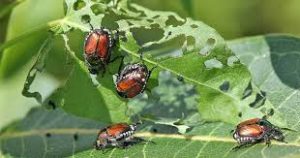Japanese Beetles & Grubs
 Have you ever gone out to your garden and noticed what once was a fully bloomed leaf has now begun shredding with multiple holes in it? Maybe you even noticed a copper colored beetle clinging on chewing away at the leaf. This would be the work of a Japanese beetle.
Have you ever gone out to your garden and noticed what once was a fully bloomed leaf has now begun shredding with multiple holes in it? Maybe you even noticed a copper colored beetle clinging on chewing away at the leaf. This would be the work of a Japanese beetle.
What most might wonder is where do these things come from? They actually start as an immature white grub living in the soil feeding on plant roots, so you may not be aware of them until you see damage. As they mature they turn into a c-shaped grub and start to consume heavier roots which in turn ends up damaging the turf.
 The turf will develop patches of pale dying grass from not being able to receive enough water and nutrients. As the grubs increase the damage will increase. The turf will not be well supported and can be moved back like carpet. In August the grubs are small and are most susceptible to insecticide. When treating your lawn for grubs, aerating it first can make it more effective. The newly formed holes in the thatch layer mean more insecticide makes it to the grubs, killing more than it would if the thatch layer were still intact.
The turf will develop patches of pale dying grass from not being able to receive enough water and nutrients. As the grubs increase the damage will increase. The turf will not be well supported and can be moved back like carpet. In August the grubs are small and are most susceptible to insecticide. When treating your lawn for grubs, aerating it first can make it more effective. The newly formed holes in the thatch layer mean more insecticide makes it to the grubs, killing more than it would if the thatch layer were still intact.
A Japanese beetle adult however does not feed on the turf but on the foliage of the plant. They feed on many different species of plants such as vegetables, fruits, weeds and other foliage. The adults emerge from the ground from the end of May to early July.
You may want to consider planting your landscape with plants that do not attract Japanese beetles.
Some common ones to consider are:
• Lilac
• Magnolia
• Arborvitae
• Pines
• Boxwood
• Juniper
• Hydrangeas
For more information on the Japanese beetle please visit the University of Wisconsin.
